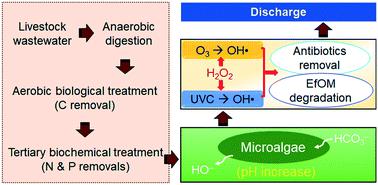当前位置:
X-MOL 学术
›
Environ. Sci.: Water Res. Technol.
›
论文详情
Our official English website, www.x-mol.net, welcomes your feedback! (Note: you will need to create a separate account there.)
Emerging investigator series: quaternary treatment with algae-assisted oxidation for antibiotics removal and refractory organics degradation in livestock wastewater effluent
Environmental Science: Water Research & Technology ( IF 5 ) Pub Date : 2020-11-06 , DOI: 10.1039/d0ew00634c Waris Khan 1, 2, 3, 4 , Joo-Youn Nam 4, 5, 6, 7 , Seokjong Byun 4, 8, 9, 10 , Sungpyo Kim 4, 11, 12, 13, 14 , Changseok Han 4, 11, 15, 16, 17 , Hyun-Chul Kim 4, 12, 13, 14, 18
Environmental Science: Water Research & Technology ( IF 5 ) Pub Date : 2020-11-06 , DOI: 10.1039/d0ew00634c Waris Khan 1, 2, 3, 4 , Joo-Youn Nam 4, 5, 6, 7 , Seokjong Byun 4, 8, 9, 10 , Sungpyo Kim 4, 11, 12, 13, 14 , Changseok Han 4, 11, 15, 16, 17 , Hyun-Chul Kim 4, 12, 13, 14, 18
Affiliation

|
In this study, we investigated the combination of algal treatment and subsequent oxidation to improve the antibiotics removal and refractory organics degradation in livestock wastewater effluent. We also proposed a better combination of oxidation processes for robust treatment of recalcitrant wastewater, mainly focusing on the removal of antibiotics. Stand-alone processes of O3, O3/H2O2, ultraviolet C (UVC), and UVC/H2O2 as well as their combined effects were evaluated as a downstream oxidation process. Prior to those oxidation processes, the effluent was treated with microalgae under continuous light illumination, which turned it into alkaline wastewater (pH > 10). The algal treatment was feasible not only to directly remove antibiotics resistant to a specific oxidation method, but also to improve the degradation of antibiotics and effluent organic matter in the alkaline wastewater upon subsequent oxidation. The alkaline wastewater was more favorable for the removal of antibiotics (especially for clopidol) with UVC treatment (UVC and UVC/H2O2). The algal treatment promoted ozonation to some extent for the degradation of florfenicol in the effluent. The removal of antibiotics by ozonation decreased with added H2O2, whereas the UVC performance was improved by adding H2O2. For ozonation followed by UVC treatment, the ozonation dominated the degradation of selected antibiotics.
中文翻译:

新兴的研究人员系列:藻类辅助氧化的四级处理去除了牲畜废水中的抗生素和难降解的有机物
在这项研究中,我们调查了藻类处理和后续氧化的组合,以改善家畜废水中抗生素的去除和难降解有机物的降解。我们还提出了一种氧化工艺的更好组合,用于顽固处理难处理的废水,主要侧重于去除抗生素。O 3,O 3 / H 2 O 2,紫外线C(UVC)和UVC / H 2 O 2的独立过程以及它们的综合作用被评估为下游氧化过程。在进行这些氧化过程之前,将废水在连续光照下用微藻处理,将其转变为碱性废水(pH> 10)。藻类处理不仅可行,不仅可以直接去除对特定氧化方法有抗性的抗生素,而且还可以改善碱性氧化废水中后续氧化后抗生素和废水中有机物的降解。碱性废水更有利于通过UVC处理(UVC和UVC / H 2 O 2)去除抗生素(尤其是氯吡醇)。)。藻类处理在一定程度上促进了臭氧化,从而使废水中的氟苯尼考降解。加入H 2 O 2可以减少臭氧的臭氧去除量,而加入H 2 O 2可以改善UVC的性能。对于臭氧化然后进行UVC处理,臭氧化主导了所选抗生素的降解。
更新日期:2020-11-12
中文翻译:

新兴的研究人员系列:藻类辅助氧化的四级处理去除了牲畜废水中的抗生素和难降解的有机物
在这项研究中,我们调查了藻类处理和后续氧化的组合,以改善家畜废水中抗生素的去除和难降解有机物的降解。我们还提出了一种氧化工艺的更好组合,用于顽固处理难处理的废水,主要侧重于去除抗生素。O 3,O 3 / H 2 O 2,紫外线C(UVC)和UVC / H 2 O 2的独立过程以及它们的综合作用被评估为下游氧化过程。在进行这些氧化过程之前,将废水在连续光照下用微藻处理,将其转变为碱性废水(pH> 10)。藻类处理不仅可行,不仅可以直接去除对特定氧化方法有抗性的抗生素,而且还可以改善碱性氧化废水中后续氧化后抗生素和废水中有机物的降解。碱性废水更有利于通过UVC处理(UVC和UVC / H 2 O 2)去除抗生素(尤其是氯吡醇)。)。藻类处理在一定程度上促进了臭氧化,从而使废水中的氟苯尼考降解。加入H 2 O 2可以减少臭氧的臭氧去除量,而加入H 2 O 2可以改善UVC的性能。对于臭氧化然后进行UVC处理,臭氧化主导了所选抗生素的降解。


























 京公网安备 11010802027423号
京公网安备 11010802027423号